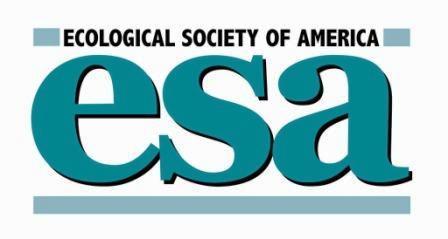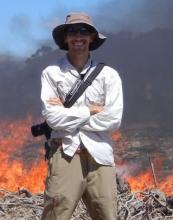Ecology
The study of relationships between organisms and their past, present and future environments.
Members of the Ecological Society of America have worked with CourseSource to create a Learning Framework for the Ecology course. The table below lists the learning goals and objectives that the Society agrees any undergraduate biological sciences major should know about Ecology by the time they graduate.
The following people worked to develop this society-approved Ecology Learning Framework:
Jennifer Doherty (University of Washington), Diane Ebert-May (Michigan State University), and Bob R. Pohlad (Ferrum College).
Download the Ecology Learning Framework
Ecological Society of America
The Ecological Society of America (ESA) is a nonpartisan, nonprofit organization of scientists founded in 1915 to: promote ecological science by improving communication among ecologists; raise the public’s level of awareness of the importance of ecological science; increase the resources available for the conduct of ecological science; and ensure the appropriate use of ecological science in environmental decision making by enhancing communication between the ecological community and policy-makers.
Course Editor(s):
Ecology Learning Framework
Society Learning Goals
Articles
Biological Diversity
How can you explain the change of biodiversity over short and long (geological) timescales?
Sample Learning Objectives- Develop an argument that there has been a change in global biodiversity over the last 100 years.
- Explain why there are multiple species of finches in the Galapagos.
What is biodiversity at the genetic, species and functional (niche) level within an area, a biome or on Earth?
Sample Learning Objectives- Create a morphological key to identify taxa.
- Use molecular biology techniques identify functional groups of organisms (e.g., soil, stream, human microbiome, ocean water).
- Conduct a biological inventory of a specific habitat.
- Develop and use a biotic index to show the quality of an environment.
- Predict and justify where you would find a specific species in a particular habitat.
- Outside the Norm: Using Public Ecology Database Information to Teach Biostatistics
- "Got Algae?" A Sorting Game for Introducing the Weird and Wonderful Diversity of Algae
- Developing Data Literacy Skills and Connecting the Student Experience in the Classroom to the Community Through Biodiversity Projects
- Biodiversity Show and Tell: An Accessible Activity to Encourage Students to Explore the Tree of Life
- Life Is Just a Game: An Active Learning Activity to Teach Life History Evolution
- Assessing Urban Biodiversity With the eBird Citizen Science Project: A Course-Based Undergraduate Research Experience (CURE) Module
- Teaching Biodiversity with Museum Specimens in an Inquiry-Based Lab
What is the relationship between phenology and biodiversity?
Sample Learning Objectives- Collect data and create a phenophase representation for selected species.
- Predict the implications at the local and global scale for observed changes in phenology.
- Relate changes in phenology to local and/or global disturbances.
Species-Habitat Interactions
How do species interact with their habitat?
Sample Learning Objectives- Compare and contrast a species with a broad range and one with a narrow range.
- Give an example of an environmental gradient, and explain the changes that one would expect to see from one end of the gradient to the other.
- Explain how somebody would depict a gradient graphically.
- Give an example of an indicator species, and explain the practical benefits of knowing that information.
- Provide two explanations for that fact that most species have clumped distributions.
- Learning the Landscape: An Active and Applied Lesson on Landscape Ecology for General Ecology Courses
- Bacteria to Brains in Backyard Coyotes: An Interdisciplinary Pedagogical Case Study
- The Power of Place: A Course-Based Undergraduate Research Experience Studying Urban Ecology, Local Apple Trees and Disease Susceptibility
- Snail Races: An Inquiry-Based Approach to Learn Invasive Species Ecology
- Debating Conservation: Developing Critical Thinking Skills in Introductory Biology Classes
- Animal Behaviour Case Study Lessons in Communication, Migration, and Parental Care Using the Jigsaw Approach
- Integrating Community Ecology Into the Study of Parasites: Exploring the Effect of Host Behavior on Parasite Transmission Rates
- A Modeling Exercise in Sexual Selection using a Student-Created Bird Species
- Moths and Frogs and E. coli, Oh My!: Agent-based Modeling of Evolutionary Systems
- How Many Squirrels Are in the Shrubs? A Lesson Plan for Comparing Methods for Population Estimation
- Sorry to Eat and Run: A Lesson Plan for Testing Trade-off in Squirrel Behavior Using Giving Up Densities (GUDs)
- Squirrels in Space: Using Radio Telemetry to Explore the Space Use and Movement of Sciurid Rodents
- Squirreling Around for Science: Observing Sciurid Rodents to Investigate Animal Behavior
- Developing Data Literacy Skills and Connecting the Student Experience in the Classroom to the Community Through Biodiversity Projects
- Ain't No Mountain Pine Enough: A Case Study of How Mountain Pine Beetles are Affecting Ecosystem Processes
- Biodiversity Show and Tell: An Accessible Activity to Encourage Students to Explore the Tree of Life
- Exploring Species Interactions with "Snapshot Serengeti"
- Using Images of Foraging Leaf-Cutter Ants to Teach Linear Regression
- Life Is Just a Game: An Active Learning Activity to Teach Life History Evolution
- Chilling in the Cold: Using Thermal Acclimation to Demonstrate Phenotypic Plasticity in Animals
- Assessing Urban Biodiversity With the eBird Citizen Science Project: A Course-Based Undergraduate Research Experience (CURE) Module
- Teaching Biodiversity with Museum Specimens in an Inquiry-Based Lab
- Authentic Ecological Inquiries Using BearCam Archives
- Coevolution or not? Crossbills, squirrels and pinecones
Populations
How can populations be distinguished from one another?
Sample Learning Objectives- Census a population and describe it in terms of: distribution, size, density, demographics and variation in characteristics (e.g., color, size, amount of pollen, type of prey, or susceptibility to pathogens).
How do populations change over time?
Sample Learning Objectives- Graphically, verbally, or quantitatively describe a population over time.
- Identify and test a hypothesis about how a population will respond to perturbation.
- Create a model explaining how populations become better adapted to their environment.
- Design an experiment to evaluate the competing hypothesis that a population in a new habitat is under selection or experiencing acclimatization.
- Escape Zoom!: Reviewing Introductory Evolution Content Using an Escape Room Format
- A Modeling Exercise in Sexual Selection using a Student-Created Bird Species
- Moths and Frogs and E. coli, Oh My!: Agent-based Modeling of Evolutionary Systems
- How Many Squirrels Are in the Shrubs? A Lesson Plan for Comparing Methods for Population Estimation
- Squirrels in Space: Using Radio Telemetry to Explore the Space Use and Movement of Sciurid Rodents
- Ain't No Mountain Pine Enough: A Case Study of How Mountain Pine Beetles are Affecting Ecosystem Processes
- A Quick and Simple Natural Selection Role Play
- Life Is Just a Game: An Active Learning Activity to Teach Life History Evolution
- What is Speciation, How Does It Occur, and Why Is It Important for Conservation?
- An active-learning lesson that targets student understanding of population growth in ecology
- A first lesson in mathematical modeling for biologists: Rocs
- Authentic Ecological Inquiries Using BearCam Archives
Matter and Energy in Ecosystems
How does matter and energy move in an ecosystem?
Sample Learning Objectives- Compare and contrast matter and energy movement in an ecosystem. (or model)
- Predict the consequences to changes in primary production due to perturbations (e.g., drought, fire, flood, temperature, nutrient changes).
- Generate and interpret carbon cycle models at ecosystem and global scales.
- Evaluate the claims in a current research paper on how a given carbon sequestration method will impact the global carbon cycle.
- Construct a model of the nitrogen cycle in an ecosystem to predict the impact of changes in the microbial community on the system.
- Breaking It Down: What Factors Control Microbial Decomposition Rates?
- Ain't No Mountain Pine Enough: A Case Study of How Mountain Pine Beetles are Affecting Ecosystem Processes
- A Lesson on Matter and Energy at the Organismal Scale: Linking Patterns and Processes Across Diverse Taxa
- Using Place-Based Economically Relevant Organisms to Improve Student Understanding of the Roles of Carbon Dioxide, Sunlight, and Nutrients in Photosynthetic Organisms
How do organisms mediate the movement of matter and energy through ecosystems?
Sample Learning Objectives- Explain the mechanisms by which microbial saprobes, parasites, and mutualists influence nutrient cycling.
- Use a model to predict the impact of the loss of a keystone consumer species on the energy flow through an ecosystem.
- Construct an argument that defends the idea that eating lower on a food chain is better for the environment.
- Explain the role of microorganisms in the loss of soil carbon after deforestation or agricultural tillage.
- Space Mission Ecology: Making Connections Among Science Disciplines Through the Lens of a Unique Plant
- Ain't No Mountain Pine Enough: A Case Study of How Mountain Pine Beetles are Affecting Ecosystem Processes
- Exploring Species Interactions with "Snapshot Serengeti"
- A Lesson on Matter and Energy at the Organismal Scale: Linking Patterns and Processes Across Diverse Taxa
- Using Images of Foraging Leaf-Cutter Ants to Teach Linear Regression
- Using Pathway Maps to Link Concepts, Peer Review, Primary Literature Searches and Data Assessment in Large Enrollment Classes: An example from teaching ecosystem ecology
How do organisms obtain and use matter and energy to live and grow?
Sample Learning Objectives- Predict and explain the difference in biomass of plants grown in the light or in the dark.
- Compare and contrast the mechanisms by which plants and fungi gain biomass.
- Explain how mass gain and loss differs between active and sedentary consumers.
- Space Mission Ecology: Making Connections Among Science Disciplines Through the Lens of a Unique Plant
- Sorry to Eat and Run: A Lesson Plan for Testing Trade-off in Squirrel Behavior Using Giving Up Densities (GUDs)
- Exploring Species Interactions with "Snapshot Serengeti"
- A Lesson on Matter and Energy at the Organismal Scale: Linking Patterns and Processes Across Diverse Taxa
- Using Images of Foraging Leaf-Cutter Ants to Teach Linear Regression
- Life Is Just a Game: An Active Learning Activity to Teach Life History Evolution
- Using Place-Based Economically Relevant Organisms to Improve Student Understanding of the Roles of Carbon Dioxide, Sunlight, and Nutrients in Photosynthetic Organisms
- Using Pathway Maps to Link Concepts, Peer Review, Primary Literature Searches and Data Assessment in Large Enrollment Classes: An example from teaching ecosystem ecology
Interactions within Ecosystems
How are living systems interconnected and interacting?
Sample Learning Objectives- Compare biodiversity among microhabitats (e.g., phylosphere v. rhizosphere, human microbiome, coral reefs)
- Predict the abiotic and biotic characteristics of new habitat over the short and long term (e.g., glacial stream, post-fire, old field).
- Choose and use multiple representations (e.g., explanation, graphs, equations, diagrams) to explain how systems are interacting (e.g., Lyme disease system, Isle Royale system, Rabbits in Australia).
- Choose and use multiple representations (e.g., explanation, graphs, equations, diagrams) to explain how organisms are constrained in the number and types of interactions in which they can engage by their evolutionary history (genetic factors) and circumstance (location, temporal variability in environment).
- Space Mission Ecology: Making Connections Among Science Disciplines Through the Lens of a Unique Plant
- Learning the Landscape: An Active and Applied Lesson on Landscape Ecology for General Ecology Courses
- Exploring Indigenous Viewpoints in the Undergraduate Biology Classroom: An Environmental Case Study Incorporating Hawaiian Traditional Ecological Knowledge
- Marsh Madness: Using Video Games and a Case Study to Explore Food Webs and Ecosystem Services in Carpinteria Salt Marsh Reserve
- Bacteria to Brains in Backyard Coyotes: An Interdisciplinary Pedagogical Case Study
- The Power of Place: A Course-Based Undergraduate Research Experience Studying Urban Ecology, Local Apple Trees and Disease Susceptibility
- Snail Races: An Inquiry-Based Approach to Learn Invasive Species Ecology
- Debating Conservation: Developing Critical Thinking Skills in Introductory Biology Classes
- Animal Behaviour Case Study Lessons in Communication, Migration, and Parental Care Using the Jigsaw Approach
- Integrating Community Ecology Into the Study of Parasites: Exploring the Effect of Host Behavior on Parasite Transmission Rates
- Moths and Frogs and E. coli, Oh My!: Agent-based Modeling of Evolutionary Systems
- Developing Data Literacy Skills and Connecting the Student Experience in the Classroom to the Community Through Biodiversity Projects
- Coevolution or not? Crossbills, squirrels and pinecones
How do systems change over time?
Sample Learning Objectives- Construct a model to explain how the interactions among the biotic and abiotic factors of a system can vary (direction, magnitude, frequency) in space and time.
- Predict and explain the response of disturbance by: -individuals (e.g., acclimation, death, migration) -populations (e.g., adaptation, migration, extinction) -communities and ecosystems (e.g., resiliency, functional redundancy, large changes to ecosystem structure)
- Exploring Indigenous Viewpoints in the Undergraduate Biology Classroom: An Environmental Case Study Incorporating Hawaiian Traditional Ecological Knowledge
- Marsh Madness: Using Video Games and a Case Study to Explore Food Webs and Ecosystem Services in Carpinteria Salt Marsh Reserve
- Escape Zoom!: Reviewing Introductory Evolution Content Using an Escape Room Format
- Moths and Frogs and E. coli, Oh My!: Agent-based Modeling of Evolutionary Systems
- Ain't No Mountain Pine Enough: A Case Study of How Mountain Pine Beetles are Affecting Ecosystem Processes
- A first lesson in mathematical modeling for biologists: Rocs
- Coevolution or not? Crossbills, squirrels and pinecones
Impacts of Humans on Ecosystems
What impacts do humans have on ecosystems?
Sample Learning Objectives- Using a long term data set (e.g., biodiversity, NPP, dissolved organic matter), examine historical and current trends for a particular habitat and explain how humans have impacted the area.
- Environmental Injustice: When the Grass is Greener on the Other Side
- Learning the Landscape: An Active and Applied Lesson on Landscape Ecology for General Ecology Courses
- Breaking It Down: What Factors Control Microbial Decomposition Rates?
- An Interrupted Case Study on Urban Prairie Restoration
- Exploring Indigenous Viewpoints in the Undergraduate Biology Classroom: An Environmental Case Study Incorporating Hawaiian Traditional Ecological Knowledge
- Bacteria to Brains in Backyard Coyotes: An Interdisciplinary Pedagogical Case Study
- The Power of Place: A Course-Based Undergraduate Research Experience Studying Urban Ecology, Local Apple Trees and Disease Susceptibility
- Snail Races: An Inquiry-Based Approach to Learn Invasive Species Ecology
- Debating Conservation: Developing Critical Thinking Skills in Introductory Biology Classes
- Is Earth Currently Undergoing a Sixth Mass Extinction?
- Moths and Frogs and E. coli, Oh My!: Agent-based Modeling of Evolutionary Systems
- Squirreling Around for Science: Observing Sciurid Rodents to Investigate Animal Behavior
- Developing Data Literacy Skills and Connecting the Student Experience in the Classroom to the Community Through Biodiversity Projects
- Biodiversity Show and Tell: An Accessible Activity to Encourage Students to Explore the Tree of Life
- Nanoparticles and Shrimp: An Interdisciplinary Lab Series in Chemistry and Biology for Undergraduate Engineering Students
- A Remote Introductory Biology Lab Using Backyard Birdwatching to Teach Data Analysis and Communication
- Using Student Perceptions and Cooperative Learning to Unpack Primary Literature on Global Change
- What is Speciation, How Does It Occur, and Why Is It Important for Conservation?
- Chilling in the Cold: Using Thermal Acclimation to Demonstrate Phenotypic Plasticity in Animals
- Assessing Urban Biodiversity With the eBird Citizen Science Project: A Course-Based Undergraduate Research Experience (CURE) Module
- Using Seafood Traceability to Teach the Complexities of Natural Resource Management and Sustainability
- Using Structured Decision Making to Explore Complex Environmental Issues
What can or do humans do to mitigate negative impacts they have on ecosystems?
Sample Learning Objectives- Create an environmental impact statement or restoration ecology plan for a specific ecosystem.
- Learning the Landscape: An Active and Applied Lesson on Landscape Ecology for General Ecology Courses
- An Interrupted Case Study on Urban Prairie Restoration
- Exploring Indigenous Viewpoints in the Undergraduate Biology Classroom: An Environmental Case Study Incorporating Hawaiian Traditional Ecological Knowledge
- Debating Conservation: Developing Critical Thinking Skills in Introductory Biology Classes
- Is Earth Currently Undergoing a Sixth Mass Extinction?
- Biodiversity Show and Tell: An Accessible Activity to Encourage Students to Explore the Tree of Life
- What is Speciation, How Does It Occur, and Why Is It Important for Conservation?
- Assessing Urban Biodiversity With the eBird Citizen Science Project: A Course-Based Undergraduate Research Experience (CURE) Module
- Using Seafood Traceability to Teach the Complexities of Natural Resource Management and Sustainability
- Using Structured Decision Making to Explore Complex Environmental Issues
Impacts of Ecosystems on Human Health and Well-being
How do humans depend on ecosystems for their health and well-being?
Sample Learning Objectives- Pick a human health issue and construct an argument tying it to the environment (e.g., water-borne disease, food poisoning, air quality, dioxin, UV radiation).
- Evaluate the claims in a recent paper about the relationship between biodiversity and human disease risk.
- Create a sustainability plan for a managed ecosystem (e.g., agro-ecosystems, forests, urban park).
- Space Mission Ecology: Making Connections Among Science Disciplines Through the Lens of a Unique Plant
- Environmental Injustice: When the Grass is Greener on the Other Side
- An Interrupted Case Study on Urban Prairie Restoration
- Exploring Indigenous Viewpoints in the Undergraduate Biology Classroom: An Environmental Case Study Incorporating Hawaiian Traditional Ecological Knowledge
- Marsh Madness: Using Video Games and a Case Study to Explore Food Webs and Ecosystem Services in Carpinteria Salt Marsh Reserve
- The Power of Place: A Course-Based Undergraduate Research Experience Studying Urban Ecology, Local Apple Trees and Disease Susceptibility
- Debating Conservation: Developing Critical Thinking Skills in Introductory Biology Classes
- A CURE for Salmonella: A Laboratory Course in Pathogen Microbiology and Genomics
- Biodiversity Show and Tell: An Accessible Activity to Encourage Students to Explore the Tree of Life
- Using Seafood Traceability to Teach the Complexities of Natural Resource Management and Sustainability
- Using Structured Decision Making to Explore Complex Environmental Issues
- Air Quality Data Mining: Mining the US EPA AirData website for student-led evaluation of air quality issues




